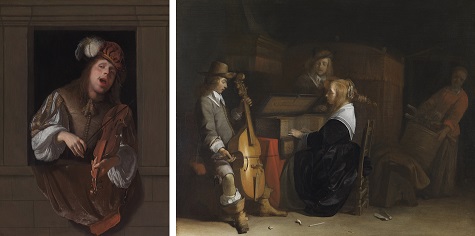Viols, virginals, flutes, and lutes! The small, masterful paintings in Vermeer Suite: Music in 17th-Century Dutch Painting, each featuring an individual playing or holding an instrument, indicate the popularity and prevalence of music—both as artistic subject matter and as activity—in the Netherlands during the 17th century.
Interestingly, the associations with music at the time ran the gamut from divine gift to causing irreparable moral damage. On one side of the spectrum, music was spiritual medicine, played solely to glorify God. On the other side, music making was perceived as a worldly pleasure and at odds with Protestant values, diverting one’s attention away from spiritual salvation. Somewhere in the middle of the spectrum, music playing and listening functioned as a polite form of entertainment for the elite upper classes. It was played in the household in the same way we might gather around and play charades or watch a football game today. Playing music was also a means for solidifying social and professional relationships, and it was a socially acceptable way for unmarried people to interact—to essentially be on a date without a chaperone. Beyond the household, elites could find a quasi-public outlet for practice and performance in a collegium musicum—a small group of amateur musicians that convened in one of its members’ homes or a location approved by the city council. Members of the lower classes could visit muziekherbergen (music inns), which made instruments available for patrons. At a music inn, a capable player who refused to perform was required to purchase a round of drinks for the whole tavern as penalty!
With the artists’ careful attention to detail and intricate treatment of surfaces, the realistic paintings in Vermeer Suite: Music in 17th-Century Dutch Painting transport us to a lively Dutch street corner or an intimate living room gathering. While we can almost hear the music that likely accompanied these scenes, visitors to the exhibition do not have to imagine it. In the exhibition’s adjacent gallery, visitors can actually listen to the paintings’ soundtracks. Songs by Jan Pieterszoon Sweelinck (1562-1621), one of the most prolific Dutch songwriters to achieve international renown, will be played continuously. A professional organist who served the Oude Kerk (Old Church) in Amsterdam for forty-four years, Sweelinck was one of the first major composers of keyboard music in Europe.
Additionally, a sound bar in this interactive gallery offers visitors the opportunity to listen to the distinct sound of each of the instruments depicted in the paintings and learn about how they were played. Visit the DMA through August 21 to enjoy the visual and aural experience of Vermeer Suite: Music in 17th-Century Dutch Painting, which is included in the Museum’s daily free general admission.
Andrea Severin Goins is the Interpretation Manager at the DMA.

